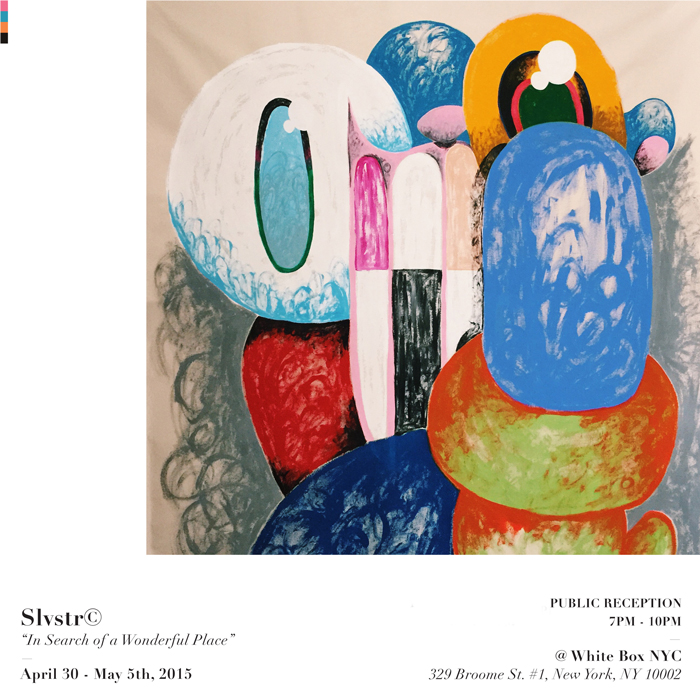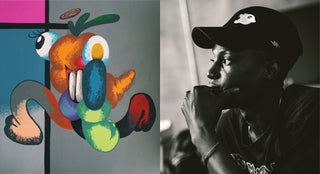Coming from a background in graphic design has both served as a launchpad and place of resistance for the artist Slvstr. From a distinct use of cyan he calls “Slvstr blue,” to his fan-favorite Murakami-esque cartoon character Sly, to the thunder bolt patterns he uses for his streetwear brand Rare Panther, the New York-based artist is no stranger to harnessing the power of brand motifs and logos to get his vision across. But now, he’s taking a leave from his design roots:
“I was approaching my art like a graphic designer and was trying to conceptualize and fine tune it. But you know, the whole thing about being an artist is that you’re not dealing with a client – you’re just expressing yourself. There’s no boundaries. You know, I just wanted to let go. So this is me just letting go.”
This process has culminated in 30 suggestive new pieces he’s presenting in his upcoming first-ever solo show In Search of a Wonderful Place this Thursday in New York at White Box NYC, which represents a great turning point in his body of work. While the words “Wonderful Place” are a direct reference to the N.E.R.D. track off Fly or Die, perhaps the search represents this liminal space between his old works and his new – in his words – more textural, natural, and “intense” paintings.
We met with Slvstr during his stay in Los Angeles. He had an informal residency of sorts at a spot in Downtown LA called Prototype Studios, after having finished two works for Anwar Carrots’ show “Carrot Field.” Slow-speaking and unpretentious, he talked to us about why it’s important to create a world in your work – in both branding and in art – and how he overcame client-like creative blocks to be able to just let go.
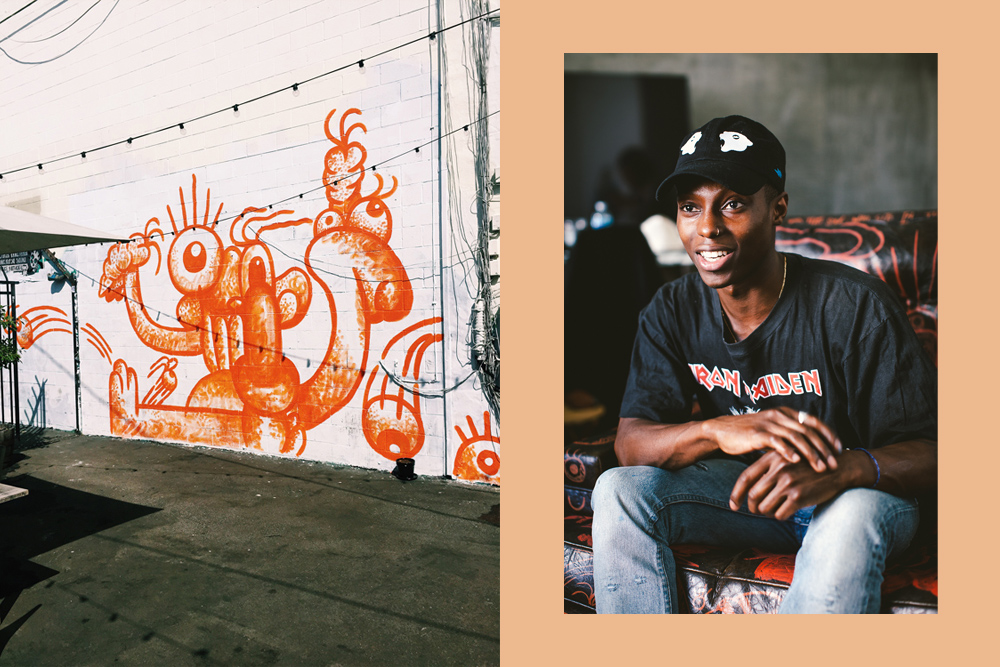
Left: Slvstr’s mural for Anwar Carrots’ Carrot Field show. Right: Slvstr.
ALINA NGUYEN: The works you’re creating now are dramatically different than your previous works. Why is that?
While I was in New York, I started to try new things and [what feels] easier and natural for me to work in. I feel like I’ve been able to create faster and [create] bigger, more intense pieces because everything feels more natural. It’s not me trying to paint perfectly, and it’s not me trying to mimic a certain energy that I want to give off. I’m not plotting these paintings – I’m just really going into working on them.
Less conceptualizing, more what?
More doing. More thoughtlessly going into it and letting the paint take you.
What do you think prevented you from getting there before?
I think when I was in New York, I got to a point where I was like, “Why am I painting? Why am I a painter?” For a minute I didn’t have anything and didn’t know what to paint. Traditionally I’m a graphic designer. That’s what I went to school for. I was approaching my art like a graphic designer and was trying to conceptualize and fine tune it. But you know, the whole thing about being an artist is that you’re not dealing with a client – you’re just expressing yourself. There’s no boundaries. You know, I just wanted to let go. So this is me just letting go. Being able to be free and do what I want.
From more of a purely visual standpoint, what are the biggest differences between your previous work to now?
Just the approach and style. I was painting everything like super flat. Which is a movement that Takashi [Murakami] started which I super highly appreciate, but then like I started researching about other artists and the movements that they were in and how they were. And for me, everything as far as art is that everything’s perfect and people are painting and creating in a way that it’s like a print out. So for me it’s like, along with me wanting to create in a way that’s super natural, I wanted to oppose that too, because life isn’t perfect and imperfections and beauty and texture for me are way better than being flat.
With your background in graphic design, was it confusing for you to transition into fine art? Did you feel disillusioned by it?
No, as far as being a graphic designer, from going to school you learn how to design things in a certain way and that’s your job and then you deal with clients. And they’re hiring you to do this job and paying you to be visual. And you know, I just never enjoyed it. I never did. So I just wanted to create and have it come from my point of view. So for me, that was just way to get my vision and thoughts and what I think and what’s going on through the world. I can just be a painter. People can either enjoy it or not.
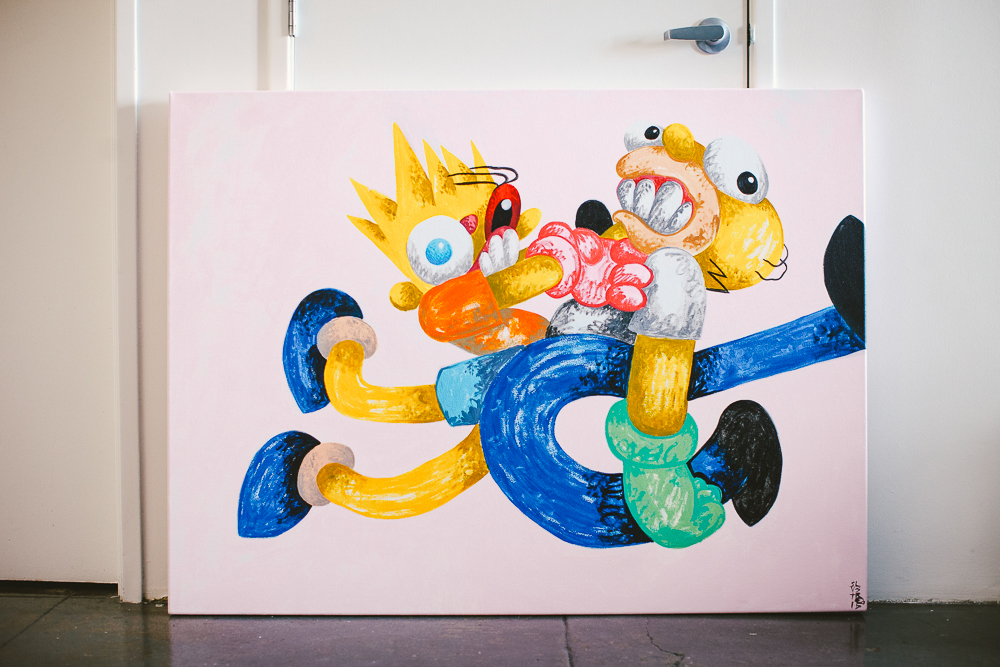
New work that will be exhibited at his show “In Search of a Wonderful Place.”

Slvstr’s character Sly, in Slvstr’s previous “flat” style.
[We] recently interviewed the artist Tim Biskup and he was talking about how he’s had some creative struggles because he wants to do something different all the time and people don’t [seem receptive to] that. They don’t like change. People see a style in your art and they want it all the time. If you don’t do it, people are like, “Yo, what happened?” How do you feel about that?
That’s what’s bad about social media. People get caught up into that and it molds like a block. I would rather my audience get used to me changing stuff up and wanting to elevate every time because then they’re seeing so many different possibilities. Like “I am that” but I am this too.
[An example is] the first way I used to draw Sly. He’s more of like a cartoon character and they got really used to seeing that. Once I abandoned that, even more people were confused, but you know they just have to work with me and understand.
I think a really solid point here is that your new work diverges from this graphic design/logo-based/brand motif-type stuff.
I knew I was, like I was like, “I have to stop.” Like I need to grow. [The change came] very naturally. Consciously, it was like, “Ay, wait a minute, I don’t want people to get used to seeing this.” I started to really ask myself, “What does my art mean to me?” and like, “How does it reflect me as a persona?” For me, if it takes me forever, I would get frustrated and wouldn’t want to do it anymore or lose interest. And I was like, “You’re not meant to be painting like this. You’re not enjoying creating art right now.”
I would talk to my ex-girlfriend, I would talk to my art dude, I would talk to Paulo, or I would talk to all my friends and they’d all be like, “Man, stop approaching your art like graphic design. Stop mapping it out and just go.” And so I would put up a canvas and I would sit and look at it and say, “What am I gonna paint without a preconceived idea?” You know what I’m saying? All these pieces of me letting the paint take me and guide me – that’s more natural and that’s why the works come out so much faster. That’s why they’re more intense. This reminds me of when I was back in high school and I’d be in my class drawing for the easy A. My teacher would be like, “Yo, all you have to do is make art and I’ll give you an A,” and I’d sit there and grab pieces of paper and do stuff. Draw cartoons, draw rappers, draw this draw that draw. I use to wear tall tees so I’d take my tall tee off and I would paint something on it wear it and it was more of me being natural and having fun with it. Now that’s where I feel like I’m at. I still haven’t lost Sly [a character Slvstr created], I still haven’t lost my thunder clouds and everything you know that people love my art for, but my approach is me now. More of me. Along with all my other influences.
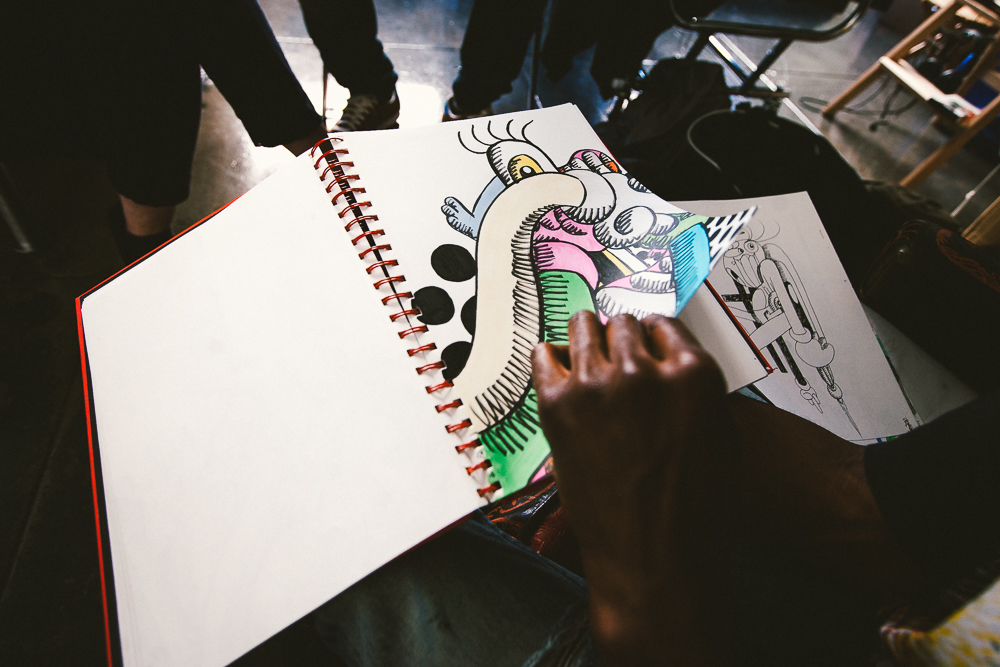
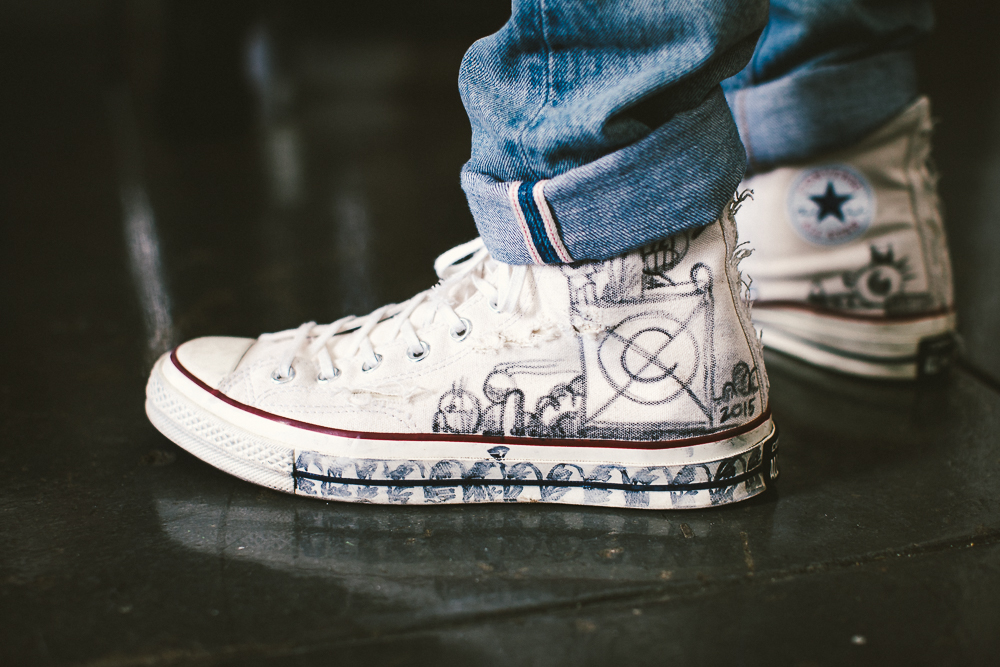
Can you talk about your connection with the color blue?
I love blue and it’s always going to be connected in some way, shape, or form. That has a lot of blue in it already. I use to always try to use this certain shade of blue. I call it Slvstr blue. Which is like a cyan, a bright cyan. Which is a darker blue in that. And I always try to have that reoccur in some way. In everything.
I think it all started from me like… So I’m like a big N.E.R.D. fan and one of my favorite songs on their Fly or Die project is “Wonderful Place” and it plays this whole song and it gets to this whistle-y tempo, just jolly – I just picture like bubblegummy-like colors and some little character skipping through the forest or something. When I listened to that song, it made me want to paint these clouds, which I call “the cloud’s wonderful place,” this cyan blue – two shades of blue-white in this [poppy], fluffy pink. I dunno, to me that was just the start of it. I always want my art to have this fun, bubbly, kinda like nostalgic vibe to it, so I want to use these colors that give you a feeling, but [with the] raw approach of how it’s painted, contrast, and the texture and the way it’s composed… give it maturity. The colors are like the kid inside and the way it’s presented to you is like the grown up.
Why is it important to you to create a world in your work?
Because when you give yourself a world to create in, it’s literally a world and you can make anything. Right now, everything is just a character and space, but that’s the style. When you create a world, there’s just so many different possibilities. When you’re growing up as a kid, you see Walt Disney and Warner Bros and Mickey Mouse and Donald Duck – they build these characters that last for time and I want Sly to be character that. Like my kids or my sister’s kids [will be like], “Oh sly made me want to get up and be happy and dream and do other things.” Even with a painting, that’s a starting point for me… eventually you’ll see Sly as a cartoon, but I feel like that’s more for the youth, and maybe instead of Disneyland I’ll have Slvstr World. But I feel like that’s where I want to take [the] “building a world” aspect – it can really be like a world.
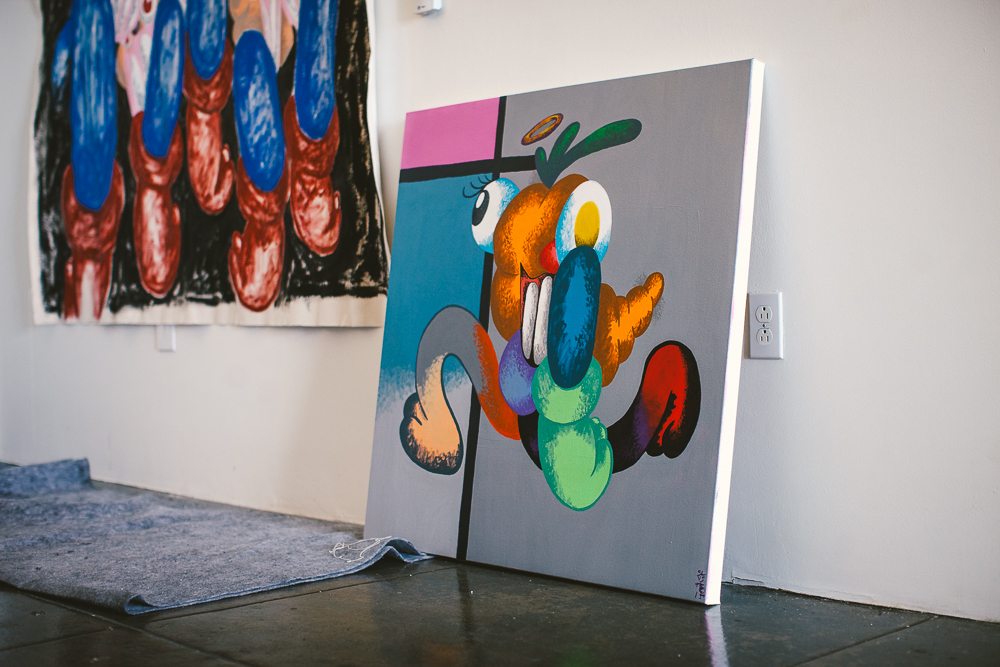
A piece Slvstr created for Anwar Carrots’ “Carrot Field” show.
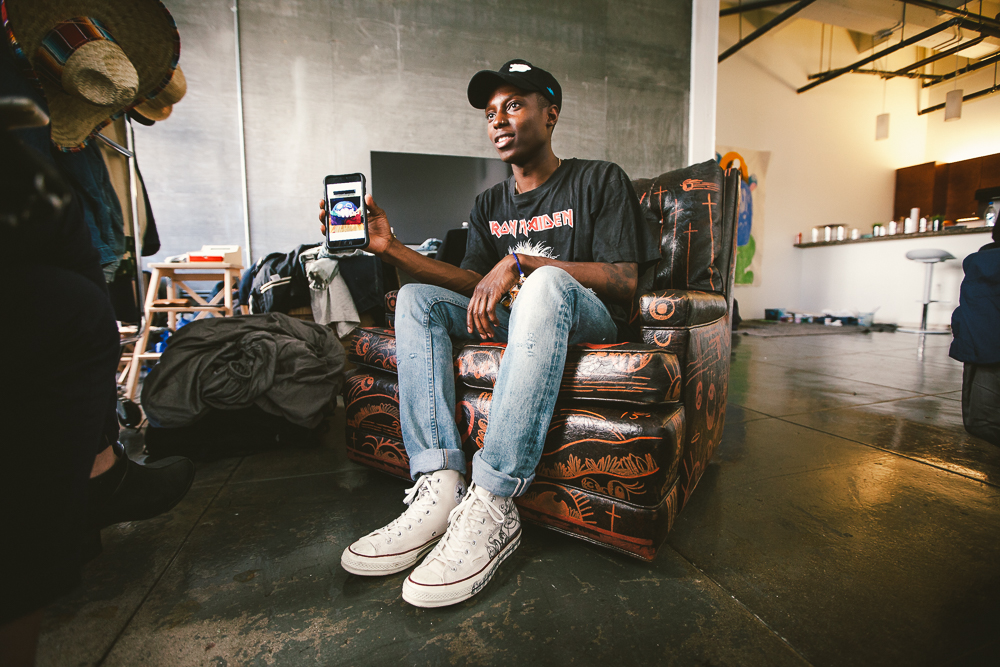
Holding up an older image of Sly on his phone.
I did read a thing about how you wanted to influence like young black artists that never knew that never knew there was a place or chance for them in art.
Coming from Oakland, California. I drew all the time and I just thought that this was something I would do because I was bored. I never thought of it as nothing I could be doing in life and making money off of. And even like to be able to do that alone is like a privilege. Hopefully for me, I’m like that person that people go, “Oh wait, he came from Oakland, like a regular kid. He’s just like us [and] did this.” I wanna be that person because I didn’t have that person to look to. I feel like I hopped on stuff late, like I didn’t find out about streetwear culture till like college.
You told us about how your bolts and clouds are different versions of the same thing and I just realized they’re all, in their own way, logos. Can you talk a bit about branding and the difference between the Slvstr brand and Rare Panther?
For me solid branding is like, you need a symbol, a typeface, and then you need a pattern, and a color – four things. So for us, Slvstr, it will always be bolts. As Slvstr and Rare Panther, you’ll always see bolts, you’ll always see blue, you’ll always see panthers, and you’ll always see these Wonderful Place prints or thunder bolt print. And that’s the branding things that we’ll always be always pushing in as many ways and variations as we possibly can.
I met this dude named Rama from the Pancake Epidemic and I was showing him my art and he was like, “Dude, whatever you do, don’t put your art on T-shirts. Don’t Sly-this on tees and don’t treat your art like [when] KAWS did Original Fake, because when you get to these collectors and guys, [who are] spending $400,000 on a painting, you shouldn’t be able to get that same level of art on a T.” So like with Rare Panther and Slvstr, that’s the beauty of it… I always wanted to separate them but still be able to relate it all together.

The bolt and thunder cloud motifs that Slvstr uses with his brand Rare Panther.
What I think is interesting about all this and your new work is that, in a way, you’ve ditched this idea of having a client, which came from your design background. You’re moving past the familiar and the logos.
In today’s age, your audience is your social media, it’s the people. People are seeing my stuff through the computer and not having not having these conversations with me so they’re rooting for me like “yeah” they see Sly like, “Yeah, go Sly!” and then Sly starts to leave and they’re like, “Bro! What’re you doing?” I was just like, “Bear with me where. I’m trying to go.”
Bobby [Hundreds] has the same tense relationship with [Adam] Bomb.
Somebody asked me the other day like, “Yo would you do a piece for The Hundreds?” and I was like I would love to make the bomb, like make the bomb in my style, like imagine a big bomb. Black, rough, textured, eye here and explosion there. You know. Like the bomb is iconic. Even though he might hate it. At the end of the day, there’s a kid out there that freaking loves it and cherishes the bomb. And in a sense back to what you were saying, it’s like streetwear and these logos – and that’s what’s in streetwear, these logo-driven brands that build these worlds out of their brands… that’s what pushes culture.
::
See more of Slvstr’s work at Slvstr.com, on Instagram @slvstrco. Follow his brand Rare Panther on Instagram @rarepanther and shop at rarepanther.com.
Slvstr’s first solo show “In Search of a Wonderful Place” is this Thursday, April 30, at White Box NYC at 329 Broome St #1, New York, NY 10002:
